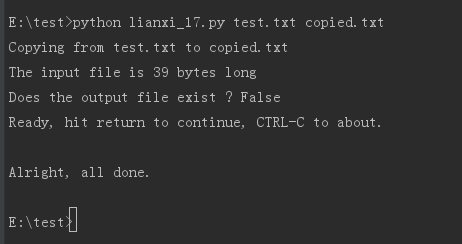习题17:更多文件操作
发布时间:2017-11-12 16:05:51编辑:Run阅读(5208)
脚本很短,不过它会让你对于文件操作有更多的了解
代码如下
# coding: utf-8
__author__ = 'www.py3study.com'
from sys import argv
from os.path import exists
script, from_file, to_file = argv
print("Copying from {} to {}".format(from_file, to_file))
in_file = open(from_file)
indata = in_file.read()
print("The input file is {} bytes long".format(len(indata)))
print("Does the output file exist ? {}".format(exists(to_file)))
print("Ready, hit return to continue, CTRL-C to about.")
input()
out_file = open(to_file, 'w')
out_file.write(indata)
print("Alright, all done.")
out_file.close()
in_file.close()import了又一个很好用的命令exists,这个命令将文件名字符串作为参数,如果文件存在的话,它将返回True,否则将返回False
通过使用import,你可以在自己代码中直接使用其它更厉害的程序员写的大量免费代码,这样你就不需要重写一遍了
应该看到的结果

常见问题
为什么'w'要放括号中?
因为这是一个字符串,表示写的意思
len()函数的功能是什么?
它会以数字的形式返回你传递的字符串长度
上一篇: 习题16:读写文件
下一篇: 习题18:命名,变量,代码,函数
- openvpn linux客户端使用
51666
- H3C基本命令大全
51297
- openvpn windows客户端使用
41755
- H3C IRF原理及 配置
38528
- Python exit()函数
33008
- openvpn mac客户端使用
30020
- python全系列官方中文文档
28699
- python 获取网卡实时流量
23674
- 1.常用turtle功能函数
23599
- python 获取Linux和Windows硬件信息
21957
- Python搭建一个RAG系统(分片/检索/召回/重排序/生成)
2139°
- Browser-use:智能浏览器自动化(Web-Agent)
2847°
- 使用 LangChain 实现本地 Agent
2372°
- 使用 LangChain 构建本地 RAG 应用
2315°
- 使用LLaMA-Factory微调大模型的function calling能力
2845°
- 复现一个简单Agent系统
2329°
- LLaMA Factory-Lora微调实现声控语音多轮问答对话-1
3114°
- LLaMA Factory微调后的模型合并导出和部署-4
5100°
- LLaMA Factory微调模型的各种参数怎么设置-3
4934°
- LLaMA Factory构建高质量数据集-2
3527°
- 姓名:Run
- 职业:谜
- 邮箱:383697894@qq.com
- 定位:上海 · 松江
